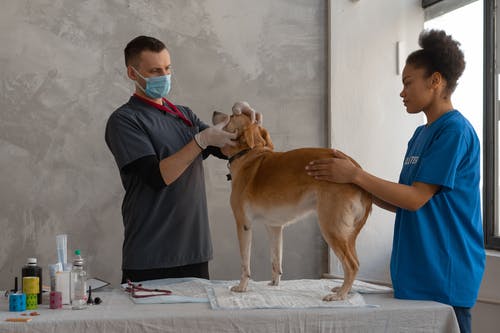Different factors can cause oral pain in dogs, including tooth decay, gingivitis, and mouth injuries. If your dogs are experiencing any of these problems, they will likely need an emergency veterinarian.
Common Causes of Oral Pains in Dogs
Here are the top most common causes of oral pains in dogs:
- Tooth Decay. One of the most common oral problems in dogs is tooth decay. Just like humans, dogs can get cavities. And when a dog has a cavity, it can be excruciating.
- Gingivitis. Another common cause of oral pain in dogs is gingivitis. It is an inflammation of the gums caused by plaque buildup. Untreated gingivitis can lead to periodontal disease.
- Mouth Injuries. Mouth injuries are another possible cause of oral pain in dogs. These can include cuts and scrapes to more serious injuries like fractured teeth. If your dog has any type of mouth injury, it’s essential to take them to a veterinarian as soon as possible for treatment.
Signs to Look for in a Dog with Oral Pain
There are a few different signs that you can look for if you think your dog is dealing with oral pain:
1. Excessive Drooling
Among the most common signs of oral pain in dogs is excessive drooling. If your dog is drooling more than usual, it could be a sign that something is wrong.
2. Pawing at the Mouth
Another common sign of oral pain is pawing at the mouth or face. If your pet is constantly trying to scratch or rub their face, they may be in pain.
3. Loss of Appetite
If your dog isn’t interested in eating, it can indicate that they’re dealing with oral pain. Dogs in pain often lose their appetite and may even stop drinking water.
4. Bad Breath
Bad breath is another common sign of oral pain in dogs. If your dog’s breath smells worse than usual, it could signify an underlying dental problem.
5. Changes in Behavior
If your dog is acting differently, it could signify that they’re in pain. Dogs who are in pain may become more withdrawn and less active. They may also start to whine or cry more than usual.
What to Expect at the Vet
If you believe your dog is dealing with oral pain, the first step is to make an appointment with your veterinarian. They can provide your dog with a thorough examination and determine the cause of their pain.
Depending on the underlying problem, they may recommend a course of treatment. This could include professional teeth cleaning, dental extractions, or other dental procedures. If it’s an emergency, the vet will likely start treatment immediately. Learn more here about pet dental emergencies.
Your dog’s oral health is essential and shouldn’t be ignored. If you think they may be in pain, don’t hesitate to make an appointment with your veterinarian.
Preventing Oral Pain in Dogs
These are some things you can do to help prevent oral pain in dogs, including:
- Brushing your dog’s teeth regularly. The best way to brush your dog’s teeth is with a pet-specific toothbrush and toothpaste.
- Giving your dog dental chews and toys. This can help to remove plaque and tartar from your dog’s teeth.
- Feeding your dog a healthy diet. A high-fiber diet can help reduce plaque buildup on your dog’s teeth.
- Visiting the vet for regular checkups. This will help recognize any problems early on and treat them before they become serious.
As a Summary
In dogs, oral pains are most commonly caused by tooth decay, gingivitis, or mouth injuries, requiring treatment from a reputable vet facility, such as La Pine Animal Hospital (click this link to visit their website).
Watch out for signs of oral pain in your dog, and take them to a reliable vet immediately if you think they may be in pain. With proper care and prevention, you can help your dog avoid oral pain altogether.







